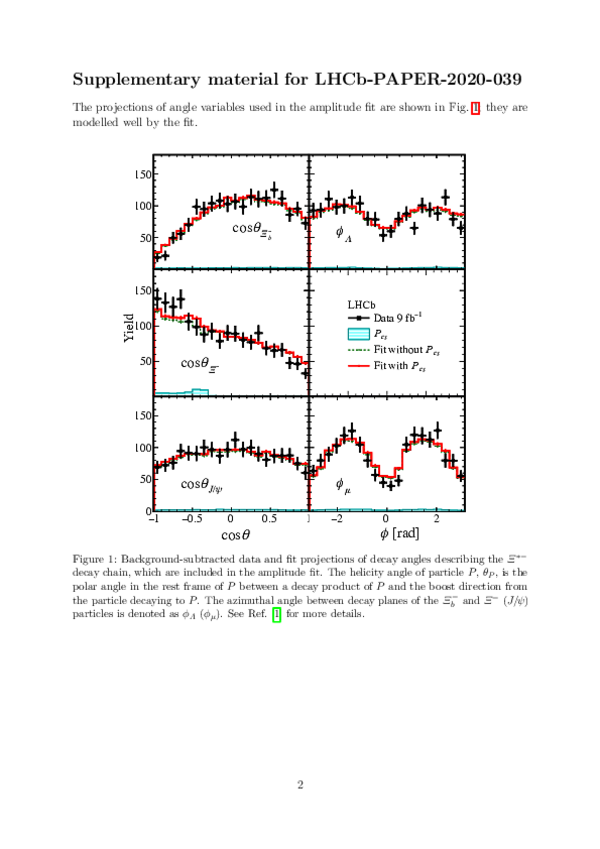Elsevier B.V. : Evidence of a $J/\psi\Lambda$ structure and observation of excited $\Xi^-$ states in the $\Xi^-_b \to J/\psi\Lambda K^-$ decay
[to restricted-access page]Information
LHCb-PAPER-2020-039
CERN-EP-2020-233
arXiv:2012.10380 [PDF]
(Submitted on 18 Dec 2020)
Science Bulletin 66 (2021) 1278
Inspire 1872884
Tools
Abstract
First evidence of a structure in the $J/\psi \varLambda$ invariant mass distribution is obtained from an amplitude analysis of $\varXi_b^- \to J/\psi \varLambda K^-$ decays. The observed structure is consistent with being due to a charmonium pentaquark with strangeness. Its mass and width are determined to be $4458.8\pm2.9 ^{+4.7}_{-1.1}$MeV and $17.3\pm6.5 ^{+8.0}_{-5.7}$MeV, where the quoted uncertainties are statistical and systematic, respectively. The structure is also consistent with being due to two resonances. In addition, the narrow excited $\varXi^-$ states, $\varXi(1690)^-$ and $\varXi(1820)^-$, are seen for the first time in a $\varXi_b^-$ decay, and their masses and widths are measured with improved precision. The analysis is performed using $pp$ collision data corresponding to a total integrated luminosity of 9fb$^{-1}$, collected with the LHCb experiment at centre-of-mass energies of $7$, $8$ and $13$TeV.
Figures and captions
|
Invariant mass distributions of selected $\Xi ^-_ b \rightarrow { J \mskip -3mu/\mskip -2mu\psi } \Lambda K ^- $ candidates in the (a) Run 1 downstream, (b) Run 1 long, (c) Run 2 downstream, and (d) Run 2 long samples. The data are overlaid by the result of the fit described in the text. |
Fig1a.pdf [28 KiB] HiDef png [397 KiB] Thumbnail [263 KiB] *.C file |

|
|
Fig1b.pdf [27 KiB] HiDef png [292 KiB] Thumbnail [222 KiB] *.C file |

|
|
|
Fig1c.pdf [28 KiB] HiDef png [386 KiB] Thumbnail [242 KiB] *.C file |

|
|
|
Fig1d.pdf [28 KiB] HiDef png [337 KiB] Thumbnail [231 KiB] *.C file |

|
|
|
Dalitz plot for all candidates within $\pm15\text{ Me V} $ of the known $\Xi ^-_ b $ mass. The yellow area shows the kinematically allowed region. |
Fig2.pdf [146 KiB] HiDef png [685 KiB] Thumbnail [454 KiB] *.C file |

|
|
The (a) $m_{\Lambda K ^- }$ and (b) $m_{ { J \mskip -3mu/\mskip -2mu\psi } \Lambda }$ distributions of selected candidates compared to the result of the fit with the $ P_{cs}^0$ state. |
Fig3a.pdf [41 KiB] HiDef png [517 KiB] Thumbnail [285 KiB] *.C file |

|
|
Fig3b.pdf [25 KiB] HiDef png [255 KiB] Thumbnail [185 KiB] *.C file |

|
|
|
(a) Projection of $ m_{ { J \mskip -3mu/\mskip -2mu\psi } \Lambda } $ in the range of $[4.36, 4.54]\text{ Ge V} $ with the $\text{ m} (\Lambda K ^- )>2.2$ $\text{ Ge V}$ requirement. (b) Projection of $\cos\theta_{P_{cs}}$ for candidates having $ m_{ { J \mskip -3mu/\mskip -2mu\psi } \Lambda }$ within one natural width from the fitted $ P_{cs}^0 $ resonance mass. The red dashed lines show the result of the fit in $\Xi^{*}$-only hypothesis and the blue solid lines show the fit accounting for both $\Xi^{*}$ and $ P_{cs}^0 $ states. |
Fig4a.pdf [17 KiB] HiDef png [272 KiB] Thumbnail [166 KiB] *.C file |

|
|
Fig4b.pdf [14 KiB] HiDef png [114 KiB] Thumbnail [105 KiB] *.C file |

|
|
|
Projections of $m_{ { J \mskip -3mu/\mskip -2mu\psi } \Lambda }$ in intervals of (top left) $m_{\Lambda K ^- }<1.9$ $\text{ Ge V}$ (bottom left) $1.9<m_{\Lambda K ^- }<2.2$ $\text{ Ge V}$ and (bottom right) $m_{\Lambda K ^- }>2.2\text{ Ge V} $ based on the default fit, superimposed with contributions from components listed in Table 1 and the $ P_{cs}^0$ state. |
Fig5.pdf [62 KiB] HiDef png [392 KiB] Thumbnail [253 KiB] *.C file |

|
|
Projection of $ m_{ { J \mskip -3mu/\mskip -2mu\psi } \Lambda } $ with a $ m_{\Lambda K ^- } >2.2$ $\text{ Ge V}$ requirement applied, overlaid by the fit using two resonances to model the peak region. |
Fig6.pdf [16 KiB] HiDef png [298 KiB] Thumbnail [161 KiB] *.C file |

|
|
Animated gif made out of all figures. |
PAPER-2020-039.gif Thumbnail |

|
Tables and captions
|
The components in the amplitude fit used to describe the $\Lambda K ^- $ system. The $J^P$, masses ($M_0$) and widths ($\Gamma_0$) of the $\Xi^-$ states are taken from the PDG [13]. The numbers of $LS$ couplings used in the default fit are listed, together with the total number of the $LS$ couplings associated to the $\Lambda K ^- $ component, given in parentheses. The $\Xi(1820)^-$ coupling of lowest $LS$ is set to (1,0) for reference. Multiple $J^P$ assignments are considered for states where this assignment has not been previously established. A nonresonant $S$-wave $\Lambda K ^- $ contribution, labelled as NR, is also considered in the fit model. |
Table_1.pdf [71 KiB] HiDef png [55 KiB] Thumbnail [27 KiB] tex code |

|
|
Mass ($M_0$), width ($\Gamma_0$) and fit fraction (FF) of the components involved in the default fit. The masses and widths of the $ P_{cs}^0$ , $\Xi(1690)^-$ , and $\Xi(1820)^-$ resonances are free parameters, while those of the other $\Xi^{*-}$ resonances are constrained by the known uncertainties [13]. The quoted uncertainties are statistical and systematic. When only one uncertainty is given, it is statistical. |
Table_2.pdf [69 KiB] HiDef png [79 KiB] Thumbnail [44 KiB] tex code |

|
|
Summary of absolute systematic uncertainties for the fit parameters. The units for masses ($M_0$) and widths ($\Gamma_0$) are $\text{ Me V} $. The fit fraction in percent is denoted FF. |
Table_3.pdf [66 KiB] HiDef png [80 KiB] Thumbnail [37 KiB] tex code |

|
Supplementary Material [file]
| Supplementary material full pdf |
supple[..].pdf [251 KiB] |

|
|
This ZIP file contains supplemetary material for the publication LHCb-PAPER-2020-039. The files are: Supplementary.pdf : An overview of the extra figure *.pdf, *.png, *.eps : The figure in variuous formats |
Fig1-S.pdf [35 KiB] HiDef png [383 KiB] Thumbnail [313 KiB] *C file |

|
Created on 26 April 2024.
